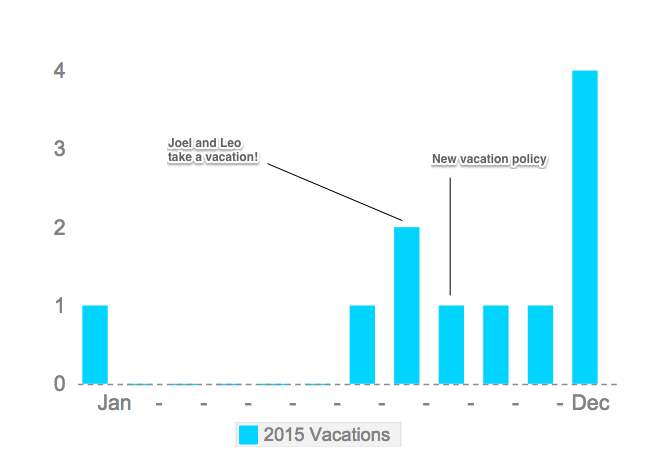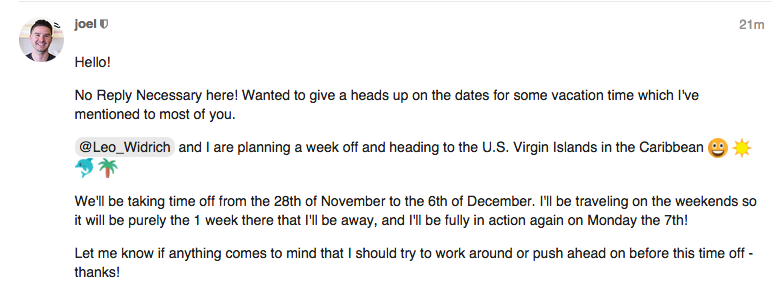What job perk could possibly be better than unlimited paid vacation days?
Just picture the perfect work/life balance, the quality time you’d spend with family and friends (or maybe just a good book on the beach).
When I first began to catch sight of job openings with this distinctive perk, it seemed nearly too good to be true!
Now that I’ve been the lucky recipient of such a policy at Buffer, it’s fascinating to see things from the other side, too. At our startup, we’ve found that unlimited vacation time isn’t always as simple as it might seem—at least, not without a few important tweaks.
As a result, this year we’ve made major changes to our vacation policy–in effect, we now pay each teammate at least $1,000 to take a vacation every year.
If you’re interested in making sure your team has the time and space away from work that they need to return fresh and full of ideas, here are some tips and methods we’ve uncovered.
Unlimited vacation: A tech perk going mainstream
Although less than 1% of employers offer unlimited paid vacation time, that doesn’t always feel like the case in the perk-heavy atmosphere of Silicon Valley startups.
Netflix, Hubspot and Evernote all tout the policy, which has even crossed over into the mainstream through companies like Virgin America and Best Buy.
There are definitely some cool pros to the policy, like being trusted by your bosses and having the freedom to do whatever you want with your time through a policy that’s fair and level across the board.
The problem with unlimited
But how do these policies do at their goal—actually getting employees to take time off? Turns out, not always so great.
In one company’s case study, people actually ended up taking far less time off. Both the Los Angeles Times and Kickstarter actually ended up rescinding their unlimited vacation time policies following similar challenges.
What turns this incredible perk into a bit of a landmine? A few elements:
- A bias against vacation time: Americans are vacation-averse to begin with. 56% haven’t taken a vacation in a year, the average American employee only takes half of their days off, and 61% report working during vacations.
- Decision fatigue: Because an unlimited vacation policy isn’t explicit about how many days off someone should take, we’re all mentally weighing each day and how it makes us look to others. That takes a lot of mental energy—so much so that we might end up choosing nothing.
- “Superjobs” keep us motivated to work: We often talk about how work is pretty fun at Buffer. We have the privilege of what Bloomberg writer Megan McArdle calls “superjobs”: “The people who do these jobs have a very high level of commitment to their work, partly because the people who do them tend to be hard-working, and partly because being a successful professional is such a deep part of their personal identity and ethos.” That can make it tough to walk away, even for a short time.
- Unspoken expectations: Writing at The Muse, Gusto CEO Joshua Reeves shares what is often unspoken about unlimited vacation policies: expectations still exist. “Even if your time off is technically ‘unlimited,’ your manager obviously doesn’t expect you’ll take off 75% of the time. Actually, he or she probably has at least a general range of number of days or weeks in mind that is acceptable for an employee to take off—even if that range hasn’t been openly communicated.”
‘We noticed we weren’t taking any’
When they first created a vacation policy in the early days of Buffer, cofounders Joel and Leo didn’t know yet that we’d experience all these factors at their own startup. In fact, Leo says they didn’t think about an unlimited vacation policy very deeply at all.
“I don’t think we had given unlimited vacation a lot of thought at the time we set the policy,” Leo says. “We knew everyone in Silicon Valley did it, and it sounded good; it felt like something that was good for people.”
“It was only over time that we noticed, in our own experience, that we weren’t taking any.”
For Joel and Leo, the light bulb went on when they took a vacation to Mexico following a particularly busy period for Buffer in the summer of 2014.

“It was probably the first full switch-off vacation we’d had since starting the company,” Joel says. “We didn’t open our laptops; we didn’t even have wifi in our apartment. And we came back feeling super refreshed and great.”
In line with our “live smarter, not harder” value, they wanted everyone at Buffer to have the same feeling.
“By the time you need a vacation, it’s too late,” Leo says. “In the western world, we go to the doctor when we’re ill. Eastern medicine promotes the idea of going to the doctor when you’re healthy, to talk about preventative care, things we can keep improving. That’s the method I’ve started to think about for vacation. I want to plan ahead so I don’t ever want to fully deplete myself .”
New policy: At least a $1,000 bonus to vacation!
Our new vacation policy went into effect at our New York City retreat in September 2014. Immediately, all teammates were eligible to claim a $1,000 bonus (plus $500 for each partner and family member) to use for travel expenses around a vacation of their choice.
From the vantage point of someone who has been lucky enough to be at Buffer both before and after the vacation policy change, it was really amazing to see how Joel and Leo going on vacation, combined with our new vacation policy, freed so many of us to take time off.

it was a true delight to see my teammates exploring the world guilt-free through this change, and to be able to do so myself (I chose an Alaskan cruise).
It reminds me of this post Joel wrote about the reason he believes so strongly in our retreats:
“Often travel or moving can be something that you delay for many years. It’s easy to convince yourself that the only way to travel or explore is to work for 5 years and then take 6 months off between jobs. At Buffer, anyone can travel or move anytime. It’s hardly even noticeable … We try to weave this notion of doing what you love and what you’re passionate about and believe in, right into the culture of the company.”
4 ways to make unlimited vacation work
Our way definitely isn’t the only way to make an unlimited vacation policy work. Here are some interesting methods and ideas from other companies and thinkers.
1. Be explicit about minimum time off
Hubspot takes some of the guesswork out of its unlimited vacation policy by referring to as “two weeks to infinity.“
This makes it explicit that employees are expected to take at least two weeks off—a big help in navigating the cognitive overhead of figuring out what a good amount of vacation might be!
Employees are also urged to share if they feel their job is too busy to get away so they can get help to make it work.
2. Offer vacation bonuses
Evernote—Buffer’s vacation inspiration—isn’t the only company offering a vacation stipend to encourage time off.
FullContact now offers what they call “paid PAID vacation” to its employees. Once a year, each staff member gets $7,500 to go away. The cash comes with three stipulations: Employees have to really take a vacation, they must completely disconnect from technology, and they aren’t allowed to work while away.
“The new policy is great for workers, but it’s also good for the company. On the one hand, it’s an incredible recruiting tool; resumes are pouring into FullContact. On the other, it forces employees to ditch the “hero mentality”–the idea that no one else can do the job but them.”
3. Help your team make time
Managers can be a huge factor in making sure their teams take fair amounts of time off by making it a priority.
In the absence of a “use it or lose it” type policy, employees might need an extra nudge to up the urgency.
“I’ve started to ask regularly in one-on-one conversations, ‘When was your last vacation?'” Leo says. “I want to start to encourage it, if it was a while ago I might ask if you want to take a vacation. It’s about helping people to regularly make that time. You get to a point where you really need time off, and it’s easy to push it out and push it out.”
Another great tip from a killer post on this topic: Regularly review time off for systemic bias, as part of a equal pay review.
4. Lead by example
Getting a cash bonus for taking a vacation is nice—like, incredibly, miraculously nice.
But for me, seeing Buffer’s founders take their own time off was just as important as the extra cash. If you want your team to model healthy habits, it really helps if they can see you acting them out. And that “takes a lot of self discipline,” notes Leo.

“A construction worker can’t just keep building a little bit at home,” he says. “We have the freedom to choose when to work and how much and where, and that freedom comes with effort to make a decision and structure our days.”
Seeing the way Joel and Leo disconnected on their vacation and came back with tons of new ideas for Buffer made me really ready to do the same!
Over to you
Vacation time and the many feelings and emotions surrounding it is such an interesting topic.
When’s the last time you took some vacation time? How do you feel when you take time off? What could you or your company do to encourage a healthy attitude around time off?
I can’t wait to hear your thoughts in the comments!
Try Buffer for free
190,000+ creators, small businesses, and marketers use Buffer to grow their audiences every month.




